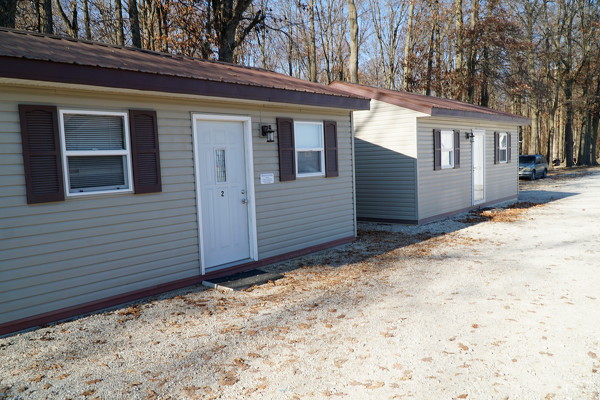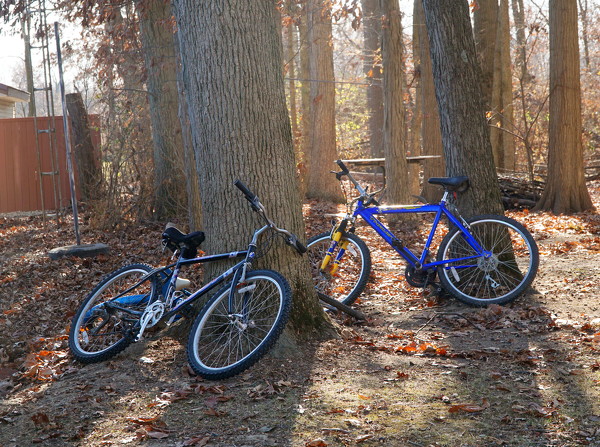Wednesday, November 30th, 2022
Homeless on the Holidays
Group working to offer shelter against the cold
By Bob Tomaszewski

Photo by Bob Tomaszewski/The Daily Standard
The Hand Up Village in Celina houses 15 to 20 people at any given time, though the need is much greater.
MERCER COUNTY-Being homeless is hard under any circumstances, let alone when temperatures dip into the 20s at night and the razor-edged wind off the lake cuts to the bone.
Organizations in Mercer and Auglaize counties offer assistance, but organizers say they are swamped while homelessness persists.
Hand Up Village is a community of cabins near Abounding Grace Church in Celina, where homeless individuals are offered a place to stay while they build their savings for a few months.
"I believe the (homelessness) problem is bigger now than it's ever been in Mercer County," Hand Up Village founder Rev. Rick Brosher said. Brosher, a senior pastor at Abounding Grace, has been operating Hand Up Village since 2015.
"You can't be a Christ follower and not have a heart for people," he said. "Long before the cabins were here, we had folks staying in camps or staying in their cars. I just knew we had to do something."
Brosher said he used to average three calls per week from other organizations looking for an open place for clients. Now he gets more.
Auglaize County Emergency Management Agency Director Troy Anderson said his call volume is similar for the Auglaize County Homeless Coalition, a group dedicated to combating homelessness.
"My weekends are usually busy, last week we had four calls," he said.
Several churches are part of the effort.
"What we were finding was that the homeless individuals were going to the churches, asking the congregation for help," Anderson said. "What we were finding was, if we pulled everybody together and brought them on the coalition, we can do better with our funding," he said. He explained that by working together the groups avoid duplicating resources and can stretch funds further.
Mercy Unlimited, Wapakoneta, and Agape Ministries, St. Marys, function as primary case managers on each side of Auglaize County. Anderson said the coalition works with Job and Family Services and Western Ohio Community Action Partnership along with other state agencies to obtain grant funding.
However, assistance usually lasts a few months.
"We are not a long-term (assistance) organization," Anderson said. "We are there to try to help them, we are trying to get them in a shelter, temporary housing. At the same time we are trying to help them find a better job or finding a place they can afford."
The biggest challenge is finding affordable housing, he said.
Anderson said he would like to see a designated housing complex for clients, rather than setting them up in a motel for a few days.
Ideally, the Auglaize County Homeless Coalition would have housing complexes on both sides of the county and an onsite case manager at each location, similar to Hand Up Village. But for now, that idea is a ways away from becoming a reality.
"Our numbers are sitting around 105 to 110 (people). Those are ones that we have helped right now," Anderson said. He said individuals using the coalition's services have ranged in age from 18-82.
In many cases the homeless population is hidden. Although many people think of homelessness as people living on the streets, homelessness also applies to an individual or family who lack a fixed, regular and adequate nighttime residence, such as those living in emergency shelters, transitional housing, or places not meant for habitation, according to the U.S. Department of Housing and Urban Development.
"We have people living in campers, we have people living in sheds, we have people sleeping on porches," Anderson said.
Anderson said point-in-time counts for homelessness in the county used to show zero for Auglaize County. Point-in-time counts provide a snapshot of visible homelessness on a given winter night. The coalition found nine people experiencing homelessness by walking the streets for a night last winter.
State statistics are less than helpful for painting a picture of the local homeless situation, according to Brosher.
"If you look at the (point-in-time) study that the state does they will tell you that Mercer County really doesn't have a homeless problem," he said. "They go looking outside homeless camps, we really don't have any in Mercer County. They look at how many people that they can see on the streets."
He explained homelessness in Mercer County often takes the form of car camping and couch surfing.
"We had one guy that was living under a bridge out by Walmart," Brosher said. "When you don't have a place to go you are pretty happy with anything to get a roof over your head."
The individual was able to come to the village and acquire a job.

Photo by Bob Tomaszewski/The Daily Standard
Tri-Star students helped enclose and frame a cabin at Hand Up Village.
Brosher said the village has steadily grown since 2015.
"We have 12 living spaces now," Brosher said. "We usually have between 15 and 20 people living out here."
Those who have come to the Hand Up Village come from all age groups.
"The oldest person we've ever had out here is 92," he said. "This year the majority of the people we've had have been between 18 and 22. Just over a week ago for several nights we had four teenagers, staying in a car out here, all of them 18-19 and nowhere to go."
He said the teens felt it was a safe area to park.
"The majority of the young people that we get come from very dysfunctional homes or the foster system," Brosher said. "It's a real challenge because of the chaos they've been raised in, they don't know what normal is."
Another individual had medical problems and was unable to work for two to three months.
"I get more phone calls then I've ever gotten. Of course, there is nothing else in Mercer County, this is it," Brosher said of homeless services. "The local agencies are always calling me, the jail, (Mercer County) Council on Aging, Job and Family Services, Foundations (Behavioral Health Services), Momentum (Counseling). Most of the time I am saying no, I don't have anything available."
Brosher said housing is so scarce in Mercer County that people often spend about six months at the village before moving on.
"Without a place to shower and take care of yourself it can be hard to hold down a job," he said.

Photo by Bob Tomaszewski/The Daily Standard
Transportation is a challenge for the homeless. Some ride bikes or walk while others catch rides from friends.
Another issue is reliable transportation. Brosher said many of those at the village will ride bikes or simply walk if they don't have a ride.
"Transportation is one of the toughest things," he said.
To help with these issues, 50% of what people earn from their job while they live at the village is stored in a savings account. Brosher said organizers prefer to have clients save at least $3,000 before moving on from the village. The money will eventually go toward deposits for rent or a vehicle.
"I think this is the best ministry I've ever been involved in my life, but it is also the most challenging thing and most stressful thing," he said. "You take this home with you, you can't just put it aside. You can't put people aside (and) you can't put (aside) the problems they are having. (Clients) have to want it worse than you want it for them, and sometimes they don't want it worse than I want it for them. That's extremely frustrating. We want to help folks."




